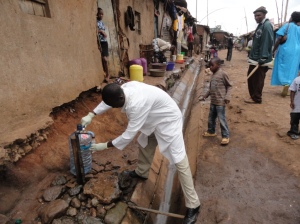I apologize for the delay in posting to the blog. It isn’t due to lack of activity, but rather an overwhelming volume of activity as we rapidly approach the launch of Life Force Kiosks in Kibera. I’ll write another post in the next couple of days on the launch, but first I wanted to share the results of the Kenya Medical Research Institute (KEMRI) testing.

KEMRI Water testing in Kibera
As we have 12 vendors starting in our pilot, we decided to do a full census of water points and pulled water samples from all 12 taps. We also pulled samples from several other taps in Kibera as well as directly from households. As a reminder, we split each sample into four sub-samples and treated them with 0, 1, 2, or 3 ml of chlorine. When untreated, we saw dramatically high rates of fecal contamination. In our pilot area, about 42% of taps showed unsafe levels of coliforms in the water. In other areas and with household samples that number was even higher.
While that was somewhat expected, the really exciting news was that KEMRI found that only 1 ml of chlorine was enough to reduce the coliform count to safe levels. This means that Life Force Kiosks can achieve the desired health impact without dramatically impact the taste and smell of the water. KEMRI also tested for contamination of water containers before and after Life Force Kiosks washed them. We tested 10 containers, and in all cases the container showed some level of contamination prior to cleaning but no unsafe contamination after the thorough cleaning with soap and chlorinated water.

KEMRI Water testing in Kibera
I was asked the other day why the major promoters of liquid chlorine suggest a 3 ml dosage. It’s a great question, and I believe they have two very good reasons for doing that. First, they are promoting packaged chlorine across a huge geographic region and can’t adjust their dosing directions for each specific community. If packaged chlorine like WaterGuard is being used in areas with untreated water (from wells, streams, etc.), a higher 3 ml dosage may be required. Life Force Kiosks is fortunate to be able to conduct ongoing testing in our specific operating areas and adjust the dosage accordingly. Second, I believe they encourage a higher dosage to ensure there is residual chlorine in the water that will prevent re-contamination. This is not a bad idea. However, Life Force Kiosks is in the position to offer storage container cleaning services alongside the water purification service. This dramatically reduces the risk of recontamination so we can offer a lower dose of chlorine, thus protecting the taste and smell without dramatically increasing the likelihood of re-contamination. We will conduct this testing on a regular basis to ensure that our model continues to be effective.
KEMRI has reviewed the results and has given us their green light to start operations in Kibera. We are very excited to now have full confidence that our model will reduce waterborne disease, and I want to personally thank Professor Karama of KEMRI, Professor Ichinose Yoshio of Nagasaki University who works with KEMRI, and the entire KEMRI lab team.
Read Full Post »






















